
If the leafy lanes of West Sussex were no substitute for the sweeping curves of Spa Francorchamps or tortuous back roads of rural France in 1964, the sensation of speed must have been similar. The 2006 take on one of the world’s most iconic cars may well be faster than the original, and it’s certainly a lot more comfortable to drive.
It’s difficult to know where to begin with this one. Sharing the same designer (Peter Brock) as the original, a tubular chassis and front-mounted American V8 - and now carrying the Shelby name - the latest Daytona Cobra is designed to be like an original 1960s competition coupe yet have just enough comforts and modern manners to make the novelty as durable as possible. Most people should know that the 1960s Daytona Coupe was designed to give a Shelby Cobra some streamlining, and allow it to take on the then all-dominant Ferrari 250 GTOs in period GT racing. Its name comes from its debut at the famous Florida race track in 1964.
I had to read the spec sheet thoroughly to realise the car is actually 2% larger overall than its 1964/65 ancestors, such is the fidelity of line and proportion. The increase in size was essential to allow the occupants some degree of comfort, and enables a roll-cage to be fitted, together with a seat on runners – neither of which would have been in the original.
Despite this, it’s a tightish cabin that greets the average-to-large driver, but one that becomes roomier with acquaintance. The transmission tunnel takes up a lot of space and really separates driver from passenger. The doors are opened remotely (á la TVR) on the key fob of the alarm that’s standard on the car, and to open them from the inside you press a button under the dash. It’s fiddly, but more familiar with time no doubt.
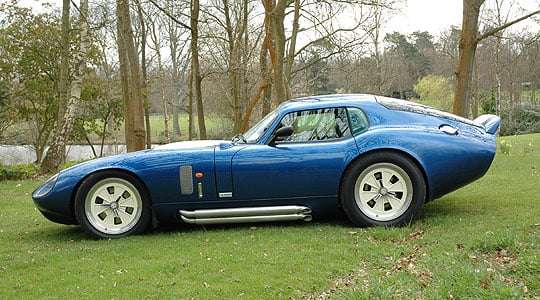
Strap yourself in with a normal 3-point inertia-reel belt, turn the key and flick down the toggle ‘Start’ switch and prepare for action. As it’s a fully road-legal and registered car, there’s not the ‘emptying bricks into a builder’s skip’ noise I was expecting (although alternative exhaust set-ups can be installed), but make no mistake – you know the engine is running with the barking growl only a blueprinted 500+ HP American V8 (by legendary NASCAR tuner Roush) can make.
The gearbox is an all-modern Tremec 5-speed (with 6-speed a probably unnecessary option) and the clutch pretty docile so snicking the car into first, off we go. The cabin and dash layout is intentionally old-fashioned (that’s what you’re buying into!), so the small Moto Lita steering wheel seems lower-down and more horizontal than we’ve become accustomed. The test car was equipped with fuel injection so the accelerator pedal needed a firm push to start opening the multiple butterflies, again some more character of the car showing itself.
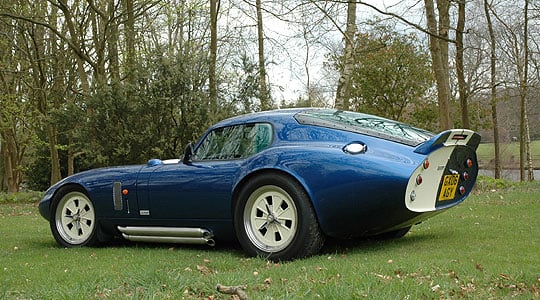
It’s fast. Oh yes, it’s fast. Revving to 6,200 rpm, it’s a typical high-performance V8 with a pretty big (402 CI, or 6.6 litres) capacity yet exhibiting the free-spinning characteristics of something smaller. Push it in 2nd or 3rd and mentally you’re soon transported back 40-odd years to a simpler time before modern driver aids. It will tear along a road in the manner of the racing Cobras we’ve all seen at the Goodwood Revival or the front-engined Panoz at Le Mans. But the engineers have done such a good job on the chassis, steering and brakes that you do feel completely in control at all times. The car bumps and crashes no more over the UK’s broken tarmac than the (excellent) Aston Martin V8 Vantage I drove last month – it really is a well thought-out and built car, and terrifically exciting to drive.
The visibility is pretty good, and comfort is aided by air-conditioning that is vital nowadays and keeps the ever-present V8 from heating up the cabin too much, as well as allowing the car to be used for longer runs.
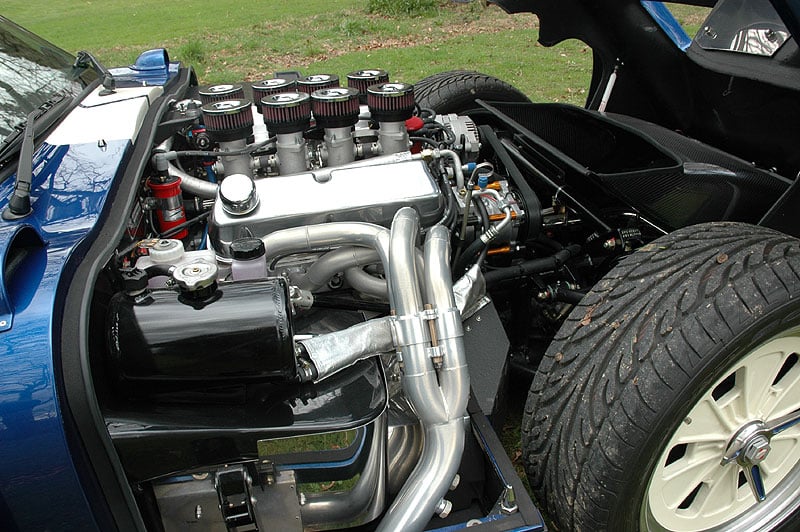
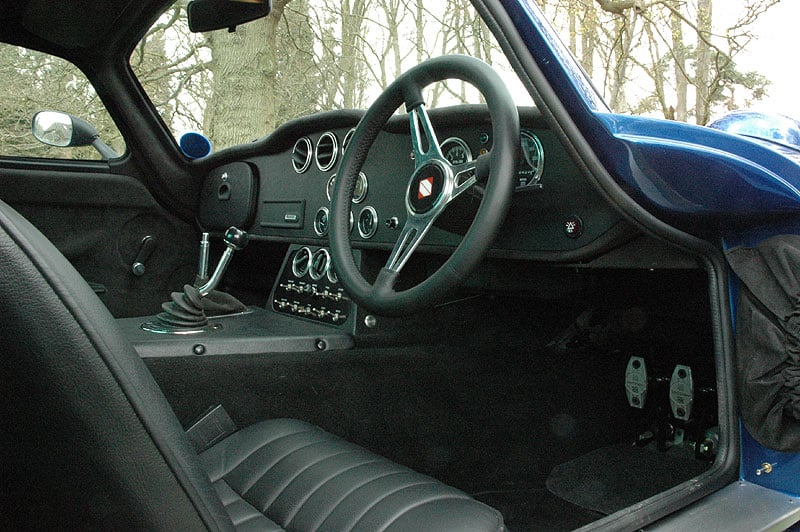
In fact Nigel Hulme, the car’s UK Importer, says “It’s something I’d quite happily take on a long European trip – and you couldn’t say that about an original!”
Mechanically, the Shelby Daytona Cobra is straightforward but deceptively sophisticated with its fully independent (and adjustable) unequal-length double-wishbone suspension, coil-over Bilstein springs and dampers, and 18” (by 8” wide front, 10” rear) alloy wheels. The tyres are Dunlop 9000 series (255 45 front, 285 50 rear) and the wheel/tyre combination is designed to give the very best possible grip yet still looking authentically ‘period’. The bodywork is of composite construction, with a tinted shatterproof screen, toughened glass side-, and tinted plexiglass rear-windows.
The engine comes complete with a dyno read-out (ours was 530 HP), and it is covered by a two-year warranty that’s administered in the UK by Roush’s offices in Essex that also look after the Ford GTs. The car itself has a one year warranty and comes completely road-legal and SVA’d with new car number plates.
The exhaust uses the original side-pipe design but actually vents under the rear valence, while the stainless steel 21 gallon fuel tank, mounted over the rear axle, is topped up with pump Premium Unleaded, so nothing special is needed to keep the car running.
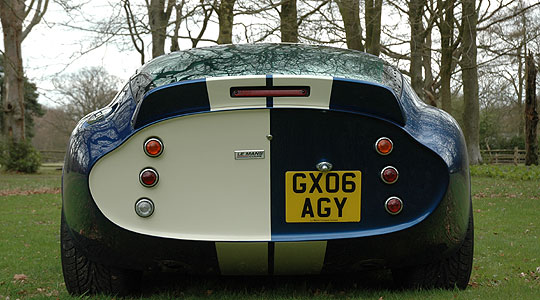
So who’d buy one? Someone who may well have a collection of 1960s cars and likes the driving sensation but wants the convenience of a ‘turn-key’ GT with the performance to beat most modern exotica. In fact at least two of the cars so far sold in the UK have gone to those very people, well known classic racers who want something a little different. And in the USA, the biggest market for the cars that are built in South Africa (at the same factory that makes Noble supercar), a specially made ‘Viking Blue’ Daytona Coupe, commissioned to celebrate the original’s victory at Sebring in 1964, sold for $270,000 at auction - a sure sign that the market is taking these cars seriously.
And my verdict? A great car with the raw ‘period’ feel and yet a well-mannered ride that belies its performance. It’s a time-machine that has the knack of being in two zones at once, and none the worse for that.
The car is priced at £78,000 + VAT in the UK and is available in right- or left-hand drive. A wide choice of body colours is available with optional stripes or roundels.
*Performance:
0-60 mph: - 3.9 secs
0-100 mph: 8.6 secs
Standing 1/4 mile: 11.5 secs
Maximum speed: 200+ mph
*Electronically and independently measured
The sole UK Distributor and Sales Agent is the AC Cobra specialist Rod Leach who can be contacted on +44(0)1992 500007 or email [email protected].
Rod Leach’s Nostalgia has specialised in the sale of AC Cobras for many years, and its current stock can be viewed on Classic Driver HERE.

Text: Steve Wakefield
Photos: Classic Driver
ClassicInside - The Classic Driver Newsletter
Free Subscription!






